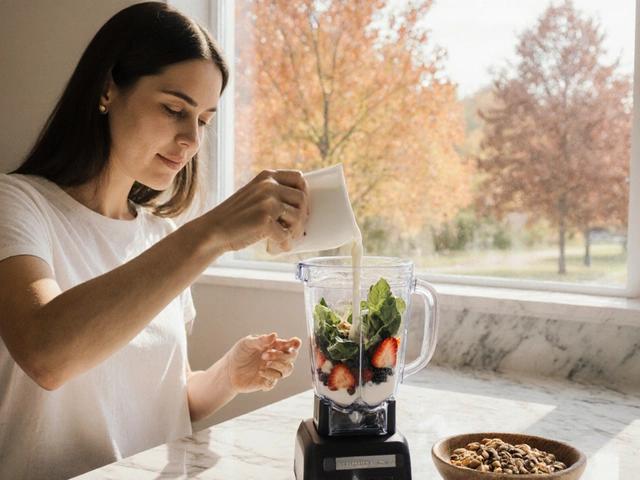BV Prevention Tracker
Log your daily habits, symptoms, and triggers to identify patterns and improve your BV prevention strategy.
Logged Entries
| Date | Symptoms | Habits | Sexual Activity |
|---|
Imagine dealing with the same uncomfortable symptoms month after month-itchy, fishy discharge, irritation that just won’t quit. That’s what many women experience with recurrent bacterial vaginosis (BV). The good news? You can break the cycle with a mix of smart habits, targeted supplements, and a little self‑tracking. Below you’ll find a step‑by‑step guide that takes the mystery out of prevention and gives you concrete actions you can start today.
Quick Take
- Restore a healthy Lactobacillus population with probiotic foods or supplements.
- Avoid douching, scented soaps, and tight synthetic underwear.
- Limit sugar and refined carbs to keep the vaginal pH stable.
- Use antibiotics only when prescribed and follow the full course.
- Track your menstrual cycle and any triggers in a simple log.
What Makes BV Come Back?
First, let’s demystify the enemy. Bacterial Vaginosis is a common vaginal infection caused by an overgrowth of anaerobic bacteria when the natural balance of the vaginal microbiome is disrupted. The microbiome usually thrives on Lactobacillus, a friendly bacteria that produces lactic acid to keep the environment acidic (pH≈3.8‑4.5). When something upsets this equilibrium-like a course of antibiotics, hormonal shifts, or frequent douching-pathogenic bacteria seize the chance, leading to BV.
Recurrent BV often stems from a few repeat culprits:
- Incomplete eradication of harmful bacteria after treatment.
- Persistent lifestyle factors that keep the pH too high.
- Underlying health issues such as diabetes or hormonal imbalances.
- Repeated exposure to new bacterial strains through sexual activity.
Adjust Your Daily Habits
Small changes can have a big impact. Here’s a practical checklist you can start implementing tonight:
- Skip the douche. Douching strips away the protective Lactobacillus layer and raises pH, creating a perfect breeding ground for BV.
- Choose cotton underwear and avoid tight leggings that trap moisture.
- Wash the external genital area with plain water or a mild, unscented cleanser. No scented soaps or wipes.
- After swimming or using a hot tub, change out of wet swimwear as soon as possible.
- Limit sugary snacks and refined carbs-high glucose feeds the bad bacteria.
These habits help maintain a low‑pH environment, which is the first line of defense.
Boost Your Defense with Probiotics
When the natural flora is weak, adding a probiotic boost can tip the scales back in your favor. Probiotics are live microorganisms, typically strains of Lactobacillus or Bifidobacterium, that colonize the gut and vagina when taken regularly. Studies from 2022‑2024 show that oral probiotic supplements containing Lactobacillus rhamnosus GR-1 and Lactobacillus reuteri RC-14 reduce recurrence rates by up to 45%.
How to incorporate them:
- Take a daily probiotic capsule with at least 10billion CFU, specifically labeled for vaginal health.
- Eat fermented foods-plain yogurt, kefir, sauerkraut, kimchi-at least three times a week.
- Consider a probiotic suppository for direct vaginal application if you’ve had multiple relapses.
Consistency matters. Give the supplements at least one month before noticing a change.

Antibiotics: Use Them Wisely
Metronidazole and clindamycin are the go‑to antibiotics for BV, and they work well-if used correctly. Overuse or stopping early can leave resilient bacteria behind, setting the stage for recurrence. Antibiotics should be prescribed only after a proper diagnosis and taken for the full prescribed duration. If you’ve had more than two courses in a year, discuss alternative regimens with your provider, such as a combination of a short‑course antibiotic followed by a probiotic maintenance plan.
Key tips:
- Never self‑prescribe; always get a lab‑confirmed diagnosis.
- Complete the full course, even if symptoms improve early.
- Start a probiotic supplement on the last day of antibiotics to help repopulate good bacteria.
Mind the pH and Hormonal Shifts
The vaginal pH is a delicate balance. When estrogen levels dip-during menopause, menstrual irregularities, or certain contraceptives-the lining becomes thinner, producing less glycogen that feeds Lactobacillus. Vaginal pH typically stays below 4.5; anything higher signals an environment ripe for BV. Tracking your cycle can reveal patterns: many women notice flare‑ups right after their period or during ovulation.
To keep pH in check:
- Use a pH‑balanced soap only on the external area.
- Consider a low‑dose estrogen cream if you’re post‑menopausal (consult your doctor).
- Stay hydrated; urine concentration can indirectly affect vaginal acidity.
Build Your Personal Prevention Plan
Putting all these pieces together works best when you have a simple, repeatable system. Below is a printable checklist you can keep in your bathroom drawer.
- Morning: Take probiotic capsule with breakfast.
- After shower: Wash with plain water only; pat dry.
- Throughout day: Wear cotton underwear, change wet clothes promptly.
- Evening: Log any symptoms, sexual activity, and menstrual phase.
- Weekly: Review log for patterns; adjust diet or supplement dose if needed.
Consistency builds a resilient microbiome, turning occasional flare‑ups into a thing of the past.
Prevention Strategies at a Glance
| Method | How It Works | Pros | Cons |
|---|---|---|---|
| Lifestyle Hygiene | Maintains low vaginal pH by avoiding irritants. | Free, easy to adopt. | Requires daily habit changes. |
| Probiotic Supplementation | Re‑introduces beneficial Lactobacillus strains. | Evidence‑backed, supports overall gut health. | Cost of high‑quality capsules. |
| Targeted Antibiotics | Eliminates overgrown anaerobes. | Fast symptom relief. | Potential resistance, disrupts good flora. |
| Hormonal Support | Boosts glycogen production, feeding Lactobacillus. | Effective for menopausal women. | Requires prescription, possible side effects. |
Frequently Asked Questions
Can BV be cured permanently?
BV can be managed long‑term, but because the vaginal environment is dynamic, occasional flare‑ups are possible. Consistent preventive habits dramatically lower recurrence rates.
Is it safe to use over‑the‑counter probiotic creams?
Yes, provided the product lists specific Lactobacillus strains (GR‑1, RC‑14) and a viable colony count. Look for third‑party testing to ensure quality.
Why does BV happen more often after sex?
Sex can introduce new bacteria and alter pH, especially if condoms aren’t used or lubricants contain sugars. Using barrier protection and avoiding spermicidal gels helps.
Should I avoid all forms of birth control?
Not necessarily. Hormonal IUDs that release low‑dose progestin are generally well‑tolerated. However, spermicidal foams and diaphragms can increase BV risk.
How long should I wait after finishing antibiotics before trying to conceive?
Most doctors recommend a one‑month washout period and a probiotic course to restore your microbiome before trying to get pregnant.

Next Steps
Start by picking one habit from the checklist and stick to it for two weeks. Add a probiotic on day three, and note any changes in a simple spreadsheet. If symptoms persist after a full antibiotic course, book a follow‑up with your clinician and discuss a combined probiotic‑maintenance plan.
Remember, the goal isn’t just to stop BV for a month-it’s to create a resilient vaginal ecosystem that stays balanced year after year. With the right mix of hygiene, nutrition, and targeted supplements, you’ve got the tools to make that happen.







Abby Richards
Great overview! I love how you broke down the steps into bite‑size pieces 😊. The tracker idea is especially handy for spotting patterns. Keep the tips coming!
william smith
Stick to a probiotic daily and ditch the scented wipes. Simple changes, big payoff.